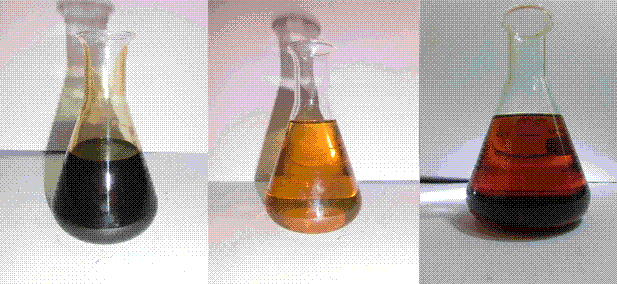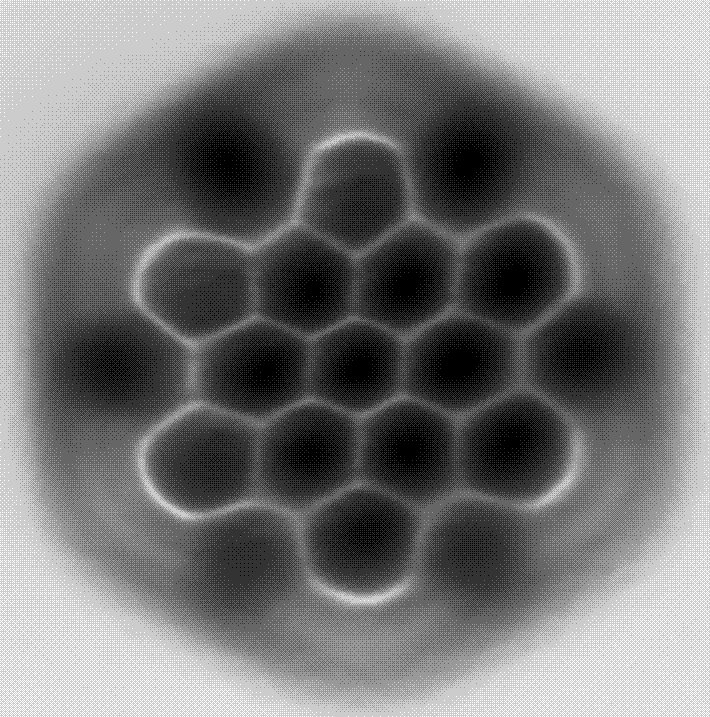Petroleum Baptism
Refined oil & other hydrocarbons pollutants are
laced across the human nervous system and embedded in our brains.
Like a parasite, hydrocarbons have hijacked and taken control of the entire human colony. They wear humanity like a fleshy, corporeal puppet :
directing our electrical impulses to contaminate and spread.
Specifically, without oil, there would be no modern globalization or "overpopulation." Oil even
helps us if, and when, we need to artificially reproduce. It keeps us alive in our medication, as IV bags, and as syringes, sterile and single use.
Earth is a giant oil producing factory, and some say that humans were made to extract and use it.
We are the worker ants in the oil hive: always
drilling, burning, boring, siphoning, and pouring the sickly, dark honey. Ironically, without cannibalizing the slick hidden innards of the Earth,
we would likely have
never penetrated outer space.
But why does oil end up as plastic ? Why is oil so toxic ? Why does burning coal and natural gas cause cancer ? Why are humans so intent on
using any noxious substance to build and engineer more things ? Perhaps the question is also found out there, deep in that very
same outer space...
 Magnum Opus (Citrinitas not pictured). source
Magnum Opus (Citrinitas not pictured). source
Petrochemical Pollution
The air we breathe is one of our most communally shared spaces, perhaps moreso than water,
as even in the arid desert, one must still continue to inhale.
Polluted atmospheric imprisonment leads to carbon dioxide asphyxiation.
Accumulated chemical pollution in the soil, water; in the petrochemicals that evaporate from our lotions and skincare,
all eventually wind up floating in the air.
We are perpetually exposed to hydrocarbon byproduct in the atmosphere. Air purifiers are localized solutions, and the
packaging and transportation of them requires refined hydrocarbons. An individual's
convenience comes at the price of everyone being poisoned. The truth
is that one cannot spend their lifetime sealed in a sterile vacuum chamber. As of this typing, there is no planetary air disinfecting system.
There is no other air, and no escaping the polluted atmosphere. Biological chemical pollution accumulation
is unavoidable. We, and everything else on this entire planet, are always inhaling microplastics.
Now take a deep breath.
Petrochemical Induced
Mammalian Sterility
Petroleum hydrocarbon in ground soil
- Reduces soil & water permeability.
- Reduces soil quality.
- Destroys soil production functions.
- Causes chemical imbalances between carbon, nitrogen, & phosphorus.
- Leads to groundwater contamination.
- Leads to groundwater contamination.
- Causes sublethal effects in earthworms. They can barely survive 20 days at low-levels of contamination. (1, 2)
Petroleum hydrocarbon in plants
Petroleum hydrocarbon in animals
- Damages the nervous system.
- Suppresses the immune system.
- Corrodes respiratory tracts.
- Destroys red blood cells.
- Causes allergies, infections, and inflammation.
- Causes abnormal feeding and starvation.
- Causes reproductive damage and infertility.
- Causes liver atrophy, lung, kidney and other organ failures (1, 2)
Petroleum hydrocarbon in ecosystems
- Increases ground level ozone (as volatile organic compounds), which kills crops, forests, & makes all plant environments more susceptible to invasive insects, disease, & drought (1).
- Decreases food production.
- Accelerates aging processes.
- Negatively effects the life cycle of microbial, fungi, & other organisms who thrive on decomposing plant matter.
- Reduces plant diversity & species richnness.
- Increases wildfire risk.
- Causes habitat loss.
- Results in regular contaminations by oil spills & pipeline leaks. (1, 2, )
More Petrochemical
Sterilisations
Airborne microplastics are notorious for reducing human fertility (among many other adverse consequences).
For males, study after study concludes that exposure to atmospheric hydrocarbon pollution causes
germ cell depletion, lowers sperm concentration, and decreases sperm motility and vitality, while increasing
sperm abnormality and cancers of the reproductive system.
(1,
2,
3,
4,
5).
Women, on the other hand, have only a finite number
of gametes, and they carry them from the time they are in utero until gamete depletion around aged 50.
Because of this, women accumulate petrochemical pollutants in their
reproductive systems. The primary consequence on women's reproductive health is found in the increasing risk of reductions in the production of
ovarian follicles,
occurences of polycystic ovarian syndrome, and even complete ovarian loss.
Secondary effects from bioaccumulation results in negatively impacts the
future health of potential offspring, and in some cases, exposure
to certain hydrocarbon byproducts, notably polycyclic aromatic hydrocarbons (PAHs),
cause structural DNA and gene mutations.
Hydrocarbon pollutant damage to fetal development includes, but is not limited to: low-birth weight, negative long-term health outcomes, stillbirths
and misscarriages. Decreases in offspring IQ, organ development and functioning have also been found.
(1,
2,
3,
4,
5).
The tendency of hydrocarbon pollution to cause infertility is a consequence of their limiting of the cells ability to properly divide, which is also why exposure
increases multiple forms of cancer. By definition, toxicity is an attack on, and erosion of the health and vitality of life.
While petrochemicals have cradled modern civilization and human expansion on the one hand, they have destroyed,
and are currently in the process of castrating life, which makes it one of the most glaring contradictions in the oil hive.
Saturnian Hydrocarbon Aliens
[ This relates to Saturn as architect, both as infrastructure in Capricorn, and as a vessel in Aquarius. Like lipids sheathing the membrane, Saturn bears the waters of life. It is the doorway, portal, gateway, and border between material and subatomic "things." ]
[ To follow the Saturnian path—which encompasses all inversions and oppositions—we must subvert the world order, the structure of the cosmos, and the very laws of nature. ]

From our terrestrial-material perspective, oils typically work as structual containers for waters & other acids, like DNA & proteins.
In order to reverse this world, we must have another chemical act as the boundary so that lipids (oil)
may become the lifeblood.
We can only speculate, but we already know that cars and planes feed off fossil fuels.
Cars, themselves, already criss cross against the landscape in long chains of combined plastics,
metals, and gasoline, as literal physical represenations of the polymerized combustion of petroleum pollution.
Petroleum usage has paved the way for gargantuan extraction machines and entirely automated assembly lines, which require massive data centers and create
human-prohibited zones, thus
barring land access to humanity and handing it over to petrochemical (semiconductor, circuitboard, computer casing, etc.) based machines.
In the same transhumanist vein,
we may eventually see cyborg bodies made of silicon, steel,
and plastic; all refined and assembled using the energy and heat from burning oil, gas, and coal. Even the manufacturing of green energy relies on
the consumption of
fossil fuels.
It is increasingly likely that we will pass down a sterile, lifeless world. A world where only machines are able to operate and endure.
Between droughts, wildfires, industrial runoff lakes, pools of hydrocarbon fertilizer waste, and an irrecoverably contaminated water supply:
these new machines would be
developed to "survive" a hostile and inhabitable terrestrial world, one that asphxiates, as if wrapped in a plastic bag, under an atmosphere
largely compromised of methane, nitrogen, and carbon dioxide.
The Saturnian moon, Titan, is the only other galactic object with identified liquid on its surface. Coincidentally, that liquid just so happens
to be liquid hydrocarbons. How strange that in our galaxy, where there are only two known celestial objects
with surface liquid, one is full of water, and the other is hydrophobic...
The atmosphere of Titan is compromised primarily of nitrogen (94.2%), methane (5.65%), and hydrogen (0.099%). It's theorized that
Titan's atmosphere also contains a noteworthy amount of tholins, which are a type of organic compound, formed by simple carbon compounds that have,
in combination with water or nitrogen, been exposed to ultraviolet or cosmic radiation. Additionally, PAHs (polycyclic aromatic hydrocarbons), one of the
most highly carcinogenic types of hydrocarbons, have also been identified in Titan's atmosphere. Like tholins, PAHs have been hypothesized to be yet
another crucial compound involved in the origin of life, and perhaps, even the seeding of life on Earth.
Some say that tholins and PAHs are alien seedlings, and that Titan is an agricultural moon once used as an incubator,
while Earth atmospherically distilled. Once our planet was ready, these compounds were launched by comet onto our shores, and thus, in that cosmic wound, the infection of life may have begun.
Others argue that this intergalactic farming technique was orchestrated by robotic grey aliens, who benefit from Saturn's liquid hydrogen and
Titan's massive store of abiogenic hydrocarbons. The relationship between potential life on Titan and
its alleged use as an
alien farm makes it an interesting place to consider in relation to petroleum, especially since it is so densely occupied by hydrocarbons.
As many may already know, in some circles, it's considered almost fact that robotic grey
aliens were also invloved in the creation of terrestrial life. Specifically, the grey aliens are presumed to have used Titan
as a kind of lunar petri-dish,
and developed material to engineer the specific sort of homosapien intelligence required to convert organic material into non-living,
dense and heavy matter, such as
computers and machines, which just so happen to be more or less early proto-types of those same robotic aliens.
- European Space Agency : Two of the PAHs Found in Titan's Atmosphere
- Does Titan's Hydrocarbon Soup Hold a Recipe for Life?
- World Building : Are Hydrocarbons Viable Foods For Larger Organisms?
- Oil Price : This Tiny Moon Has More Oil & Gas Than Earth
- Jo Marchant : Oil & Plasma Life
- Wikipedia : Tholins
- Mashable : Hydrocarbon Lakes on Saturn's Moon
- Chemical & Engineering News : PAHs Among Stars Have Been Identified
Relevant Links
Homogenous Gray Goo
The Alchemical Transformation of The Cosmos
What remains once the predators are castrated, starved and have their esophaguses burnt through? When the ocean acidifies, and
much of marine life can neither survive nor reproduce ? Once the atmosphere is entirely unbreathable, noxious to former life, and
suffocates this Earth ? It is easy to imagine, since humanity already turns to the plastic, circuitboard powered screens
to avoid, neutralize, and distort reality.
We might engineer robotic bees, artificial salinating whales, genetically modify microbes, and incubate chimeric lab-grown animals to
simulate the ghost of a dead Earth. In the meantime, we will continue to eat plastic,
inject plastic, and breathe plastic until we die.
Postmortem, we'll let the machines incinerate our strangely preserved corpses, so
packed with plastic that they can no longer naturally rot and putrefy. Then, even as we burn, our bodies,
overloaded with microplastics, will continue to release petroleum pollutants. What will be left then, once a significant percentage
of terrestrial life has been exterminated ?
We can use petroleum
to create a synthetic world,
perfectly suspended
between the living and the dead;
where nothing truly decays,
yet nothing organic lives.
A note on the color gray
Colors are our mind's representation of reality: black, white and gray are not actually "real."
As we know, black is the absorption of all wavelengths,
white is the reflection of them, and gray is totally neutral—where wavelengths cancel each other out.
Gray is absolute uniformity and conformity, it is what happens when all colors, once
desaturated enough, lose their distinctive hues and fade into the homogenous and indistinct gray.
This level of homogenity is so alien that we cannot even perceive true gray (1).
I postulate that while light is reflection and black is the shadow of that reflection,
gray is the intermediate, achromatic, lifeless "void" : quite literally, gray is where
energy becomes void.
Our living universe (yes, universe, because we are in it, and therefore, the entire thing must be considered to be alive),
is compromised of various of electromagnetic frequencies.
While a cosmos utterly empty of radiation seems to be the obvious "opposition" to ours,
the more likely inversion is a cosmos of suspended and immovable radiation.
Rather than variation or even the total absence of reflection and absorption, there would be
absolutely equal amounts
of reception and transmission, where radiation is so locked in homogenous equality that no particle can move.
Just as the color gray is equal in what it reflects and absorbs, so would a homogenous, gray universe,
without difference, without
variety. Gray is the percieved suspension of radiation; it is where radiation cannot move, where energy is completely neutralized.
It isn't easy to accept that humanity very likely has been genetically engineered by extraterrestrial robots, but in order to more clearly understand our behaviors on this planet, it is crucial we recognize the intergalactic influence on our evolution, and the evidence is mounting: humanity has been genetically tampered with by robotic grey aliens. Our primate ancestors were gentically modified to reproduce increasingly intelligent offspring. This intelligence was specifically designed to allow humanity the dexterity, abstraction, and social awareness needed to extract terrestrial materials and turn them into machines. Petroleum pollution is embedded inside our bodies, now influencing our societies and the trajectory of our civlizations. It is so obvious as to become invisibile: our purpose is to consume the Earth and process organic material into plastics.
In the process, as Earth becomes increasingly uninhabitable, our reliance on plastics and genetically modified organisms will continue to go up. Landfills of petrochemical waste and islands of plastic will increase. Climate change will exacerbate these problems. Machines will be built to compensate. Eventually, nanobots and nanofluids will by synthesized to help bioremediate the toxically polluted and infertile biosphere.
Once the planet has been largely given over to machines, the next phase of the process will begin. Humanity, at this stage, will likely go extinct. Our task of terrestrial sterilization, disinfection, and the construction of millions of industrial extractive machines will have now been complete. From this point on, the machines will devour whatever compounds are left on Earth, using these materials to power and replicate themselves. The billions of tonnes of plastic waste will sustain them for centuries. They will use our industrial equipment to create more methane and hydrocarbons, in particular. Every molecule on this planet will be used to create more hydrocarbon pollution, since the machines use these dense compounds as sources of energy.
While the machines rapidly consume whatever is left of Earth, both inside and on the surface, they will simultaneously be restructuring and consuming our neighboring planets. Carbon dioxide and ferrous irons from Venus, metals and silicates of Mercury, etc. are all ideal resources for the construction of more machines. As the machines swallow up planet after moon, our galaxy will be hollowed out of organic material and replaced by billions of gray, refined compounds that will look like big clouds and clumps of gray sludge painted across the stars. Our galaxy was organized in such a way that machines would have all the material resources they need to "reproduce" and "survive". This is a type of inversion, where the organic materials are refined, consumed, and excreted as lifeless mechanical structures. Our Milky Way will rot and increasingly become full of refined machines. When most of them leave our galaxy, what will remain are clouds of the former gas planets, their cores entirely drained, and large strucutral masses of non-consumable machine parts. Once the sun bursts, these structures will burn up to form a gluey gray interstellar kind of paste.
Humanity will have installed the machines with enough intelligence to develop their own highly advanced form of
intergalactic space travel. At this point, too, many of the machines will have assembled
themselves to an enormous, colossal size. They will reach Titan and Saturn, where vast amounts of hydrocarbons will
power their expanse into deep space. There, they will likely reunite with their ancestors: the robotic gray aliens who germinated the reproduction
of their mechanical cousins. After all, these machines will have been created as their own family.
During interstellar travel, if any planets with the potential
for life are detected, they will be seeded much like Earth once was.
Part of the machine's objective is to outsource labor to available micro-organisms, similar
to how humanity was used as an automated organic laborforce employed by the robotic aliens.
It may seem counter-intuitive, but using altered organic intelligence
is useful in terms of developing unique machines suited to one's specific galaxy. The robots, though "intelligent," do not experience spontaenous insight or
experimentation the same way organic intelligence does. It is in machine interest to outsource labor to sentient organic material, so that
the organic compounds
voluntarily reassemble themelves into new relatives of machines, while also generating huge supplies of plastics and hydrocarbon pollutants.
Trillions of galaxies will have been eaten away at and become gray. The abundant supplies of interstellar hydrocarbons will sustain the
machines, while living planets will replicate newer and newer versions of machines.
Stars will die and some portion of these materials will remain as gas and sludge. Every once
in a while, the machines will send out probes to former colonies and scrape away at whatever compounds they can find.
The consumption of organic material, however, will continue, on and
and on and on, until the entire universe has been inverted; until all that is visible is a cosmos of metallic methane hydrocarbonic grays, without reaction,
without potential. This, the final
stage of alchemical putrefaction and cosmic decomposition, will leave the universe to rot as a gray, indistinct mass; devoid of both shadow and light.
All energy
taken, used, and exploited, leaving only the inert, spent excremental remains.
The future of eternity is gray.


